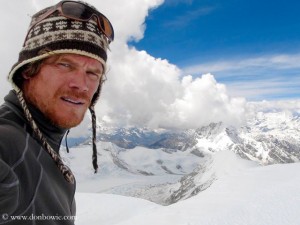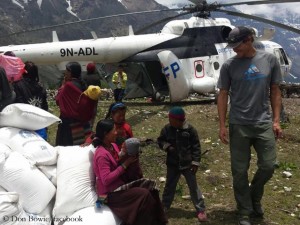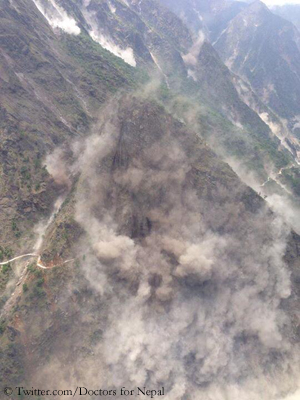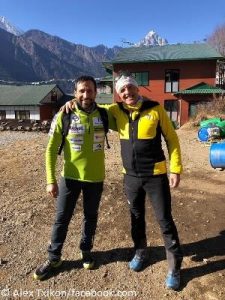Don Bowie: “Still villages in Nepal with almost no aid”
He has just stayed there – to help. When the devastating earthquake hit Nepal on 25 April, the Canadian climber Don Bowie was in Base Camp at the foot of Annapurna. For ten years, Don is climbing on eight-thousanders. By now he has scaled three of them, all without supplementary oxygen: K 2 (in 2007), Gasherbrum I (2010) and Cho Oyu (2011). After the tremors, the 46-year-old decided spontaneously to cancel the expedition and to use his skills as high altitude climber and mountain rescuer to help the earthquake victims in remote villages of Nepal. Since then Don is almost non-stop on the road in the mountains of the Himalayan state. On the Internet, he is asking for donations to finance his relief campaign. I contacted Don Bowie in Nepal.
Don, where are you staying right now?
I am based out of Kathmandu but I am now working in many districts – Gorkha, Nuwakot, Rasuwa, Sindhulpachowk, Dhading, and Dolakha.
You were on Annapurna when the earthquake hit Nepal. How did you experience the quake?
We had all just come down the day before from our high camp. We were relaxing in Base Camp when the ground started to shake. The location of Annapurna Base Camp on the north side is situated below a very steep rock cliff that has a crown of huge seracs on top of it. It was a little foggy that day, so we didn’t have clear visibility, but we heard rocks starting to come down. The entire camp started to run away from the rock fall in case the rocks rolled into our camp.
Do you feel a special responsibility to help the people in Nepal because you are a climber who has spent so much time on expeditions?
I don’t think I was motivated because of the amount of time that I have spent in Nepal, but rather the motivation came from knowing that there was an entire nation below us that was hurting and we wanted to see if we could help in any small way. With my experience in search and rescue and other valuable skills within the climbing crew, we felt that we could no longer stay on Annapurna and continue to climb with our expedition. In addition to that, we had a production crew with us that could get the message and information out about the earthquake and what was needed.
You have organized the transport of aid supplies to very remote areas of Nepal. What is most needed in these villages?
Having feet on the ground in each one of these villages and spending time with the people, you really understand what the needs are. Depending on the town, how hard it was hit, what the region was, how heavily affected their food stores were and how destroyed the homes were, each village and town has had different needs. We have tried to address those one by one, but the most prominent need, especially in the Gorkha region, is that these people are completely cut off and isolated due to landslides, so getting any food and supplies in before monsoon hits, which is starting this week, has been our primary goal.
Are there still villages without any help from outside since the 25 April earthquake?
There are still villages that I’ve been to recently that have had little to almost no aid. There have been small helicopters that have made it into the areas, but often times there has been really high mountain villages that don’t have adequate landing zones for even the small helicopters. So there are many communities that have not received very much aid and that is why we are organizing porters and mule trains to take aid into these areas. The challenge is, however, that we need to clear the trails on the way to make them safe so people can walk from village to village without being under the threat of landslides.
How do you experience the people in the remote villages? Are they traumatized, hopeless, angry?
The Nepali people are incredibly resilient. And our experience is that we come into these small towns to give aid to these people yet they offer us tea, a meal, and even places to sleep in their broken homes. They have been extremely gracious and really often times excited just to know that people were thinking of them and people from the outside world are willing to help them. We could see that they took some comfort in that.
Are you satisfied with the cooperation with the local authorities? What could run better?
Most of our experiences have been in Gorkha and we’ve only begun to expand out to other regions. However, in Gorkha, the local government has been incredibly supportive of any effort to work and coordinate alongside them. We have even been able to assign some teams to work alongside local authority and police. The government, especially in the Gorkha region where we’ve worked the most, has had an amazing and proactive role in bringing aid to these communities in a way that we have all been very impressed with.
Nepal has launched a campaign to invite people from abroad to visit the country – now more than ever. What do you think about it?
I think that there are really still some major concerns about safety in the regions that are predominantly tourist and trekking areas. I think that once the monsoon season arrives, many of these landslides will become even worse. So we are very concerned about that. I understand that restoring tourism to these areas is extremely important for local economies, and we are working very hard with many agencies – with the WFP (World Food Programme), the UN, and the local government to restore the trails and rehabilitate the village networks for road access. For now I believe that many of the regions are severely affected. Hhowever, there are regions in the east including the Annapurna circuit which appear to be almost completely intact. I think in the fall season, these relatively unscathed regions should be able to support tourism. Also if you look at the major tourist hubs such as Pokhara and even Thamel, you get a sense that these are safe areas. My team and myself have been living in these places for some time and feel quite confident that the infrastructure can support viable tourism for the fall season. However, other regions will be slow to follow because of the amount of damage and landslides.










